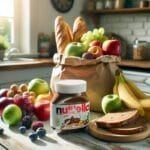What Ingredients To Avoid If You Have Milk? A Comprehensive Guide for Informed Food Choices
Category: Generic Scanners
Focus Keyword: what ingredients to avoid if you have milk?
Search Intent: Awareness
For anyone navigating the complexities of food ingredients—whether due to allergies, intolerances, or dietary preferences—the question of what ingredients to avoid if you have milk is both pressing and universal. The modern food landscape is rife with hidden sources of milk, making vigilance essential for those with sensitivities. This article explores the science, the practicalities, and the solutions available in 2025, empowering consumers to make safe, informed choices.
Understanding Milk Allergies and Sensitivities
Milk allergies and lactose intolerance are distinct yet frequently conflated conditions. A milk allergy is an immune response to proteins found in cow’s milk, such as casein and whey. In contrast, lactose intolerance stems from the body’s inability to digest lactose, the primary sugar in milk. According to the FDA, milk is one of the eight major allergens that must be declared on packaged foods in the United States. The European Food Safety Authority (EFSA) similarly highlights milk as a common allergen across Europe.
Prevalence and Impact
- Approximately 2–3% of children under three have a milk allergy, with many outgrowing it by adolescence PubMed.
- Lactose intolerance affects up to 65% of the global population, with higher prevalence in East Asian, African, and Mediterranean populations FDA.
- Recent news coverage by The New York Times underscores the challenges consumers face in identifying hidden milk ingredients.
Why Ingredient Awareness Matters
For those with milk allergies, accidental exposure can trigger severe reactions, including anaphylaxis. Even for those with lactose intolerance, symptoms such as bloating and discomfort can disrupt daily life. The proliferation of processed foods, global supply chains, and complex labeling practices intensifies the risk. As highlighted in a BBC News article, mislabeling and ambiguous ingredient names remain a persistent issue.
What Ingredients To Avoid If You Have Milk?
The focus keyword—what ingredients to avoid if you have milk?—is best addressed by examining both obvious and hidden sources. Milk is not always listed as “milk” on ingredient labels. Here is a comprehensive table and breakdown:
| Common Name | Hidden Derivatives | Typical Food Products |
|---|---|---|
| Milk | Whole, skim, powdered, evaporated | Cereals, baked goods, chocolate |
| Casein | Caseinate (sodium, calcium, potassium) | Protein bars, processed meats |
| Whey | Whey protein, whey solids | Protein shakes, ice cream |
| Lactose | Lactoglobulin, lactalbumin | Pharmaceuticals, candies |
| Butter | Butter fat, butter oil | Baked goods, sauces |
| Cheese | Curds, rennet casein | Pizzas, snacks |
| Cream | Artificial cream flavor | Coffee creamers, desserts |
| Ghee | Clarified butter | Indian cuisine, baked goods |
| Yogurt | Greek yogurt, yogurt powder | Dressings, dips |
| Custard | Milk solids, milk powder | Pastries, desserts |
Other Ingredients That May Contain Milk
- Nougat – Often contains milk powder.
- Artificial butter flavor – May be derived from milk.
- Caramel color/flavor – Sometimes uses milk derivatives.
- Protein hydrolysates – Can be sourced from milk.
- High-protein flour – Occasionally contains casein.
Tip: Always check for “contains milk” or “may contain traces of milk” statements on packaging, as required by FDA and EFSA regulations.
How to Read Ingredient Labels Effectively
Food manufacturers use a variety of terms for milk and its derivatives. The FDA mandates clear labeling, yet loopholes and international imports can complicate matters FDA. Here’s how to decode labels:
- Scan for allergens: Look for bolded or highlighted allergen statements.
- Check ingredient lists: Identify all forms of milk, casein, whey, and related terms.
- Beware of “non-dairy” claims: These can still contain milk derivatives unless labeled “vegan.”
- Review international products: Labeling laws differ by country; vigilance is key.
Recent coverage by CNN Health highlights ongoing efforts to standardize allergen labeling globally, but discrepancies persist.
Q&A: Common Questions About Milk Ingredients
Q: Are lactose-free products safe for people with milk allergies?
A: No. Lactose-free products may still contain milk proteins, which can trigger allergic reactions. Always check for casein, whey, and other milk derivatives.
Q: Is “non-dairy” the same as “milk-free”?
A: Not necessarily. “Non-dairy” can legally contain milk proteins such as casein. Only “vegan” or “milk-free” guarantees absence of all milk derivatives.
Q: What about foods prepared in shared facilities?
A: Cross-contamination is a risk. Look for “may contain traces of milk” statements and consult manufacturers if unsure.
Practical Strategies for Avoiding Milk Ingredients
- Cook at home: Control ingredients and avoid hidden sources.
- Use certified allergen-free products: Seek out brands with rigorous testing.
- Leverage technology: Apps like Food Scan Genius can scan barcodes and ingredient lists, flagging milk derivatives instantly.
- Educate family and friends: Share your dietary needs to prevent accidental exposure.
Food Scan Genius is especially useful for those with food sensitivities. By scanning product barcodes, it provides instant alerts on hidden milk ingredients, cross-contamination risks, and alternative recommendations. As one user, Maria L., shared: “Food Scan Genius changed how I shop. I no longer worry about missing hidden milk ingredients—every scan gives me peace of mind. Highly recommend for anyone with allergies!” Download Food Scan Genius today and shop with confidence.
Related Issues: Beyond Milk Allergies
The challenge of ingredient awareness extends beyond milk. Nut, soy, gluten, and egg allergies are similarly complex, each with their own hidden derivatives and ambiguous labeling. Furthermore, dietary preferences—such as veganism or religious dietary laws—require careful scrutiny of ingredients. The rise of plant-based and alternative products has improved options, but vigilance remains essential.
In a recent Guardian article, experts warn that the proliferation of new food technologies and ingredients may introduce novel allergens, underscoring the importance of ongoing education and technological solutions.
The Larger Issue: Why Ingredient Transparency Matters for Everyone
Ingredient transparency is not solely a concern for those with allergies. It is a public health issue, a matter of consumer rights, and a driver of innovation in food safety. Accurate labeling enables informed choices, reduces health risks, and fosters trust between consumers and manufacturers. As food systems become more global and complex, the need for robust, technology-driven solutions grows ever more urgent.
Conclusion: Empowering Safe Choices With Technology and Knowledge
Understanding what ingredients to avoid if you have milk is a vital skill in today’s food environment. By learning to read labels, recognizing hidden derivatives, and leveraging tools like Food Scan Genius, consumers can navigate the marketplace with confidence. This approach not only protects those with milk allergies and sensitivities, but also sets a precedent for ingredient awareness across all dietary needs.
In the end, the ability to make safe, informed food choices is a universal right. Whether you’re shopping for yourself, your family, or your community, ingredient transparency—and the technology that supports it—are essential allies. Download Food Scan Genius and join the movement toward safer, smarter eating.
References
- FDA: Food Allergies
- EFSA: Food Allergens
- PubMed: Milk Allergy Overview
- The New York Times: Food Allergy Labels
- BBC News: Hidden Allergens
- CNN Health: Food Allergy Labeling
- The Guardian: Food Allergy Labeling
Frequently Asked Questions
A1: Casein, whey, lactose, butter fat, and milk powder are frequently hidden in processed foods. Always check labels for these terms.
A2: Not always. “Non-dairy” may include milk proteins. Look for “vegan” or “milk-free” for true absence of milk.
A3: Yes. Food Scan Genius scans products for milk derivatives and cross-contamination risks, making shopping safer for those with allergies.
A4: Yes. Labeling laws differ globally, so extra caution is needed with imported foods.





